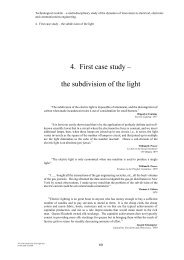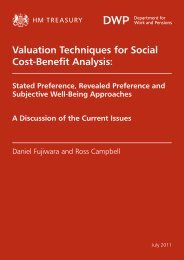NAO Good Practice Guide - Tackling external fraud - HM Treasury
NAO Good Practice Guide - Tackling external fraud - HM Treasury
NAO Good Practice Guide - Tackling external fraud - HM Treasury
You also want an ePaper? Increase the reach of your titles
YUMPU automatically turns print PDFs into web optimized ePapers that Google loves.
6 <strong>Good</strong> practice in tackling <strong>external</strong> <strong>fraud</strong> | Understanding and managing the risks of <strong>fraud</strong><br />
1.14 Costs can be spread over several years by<br />
carrying out a rolling programme of estimates.<br />
For example, the NHS Counter Fraud Service has<br />
set out to measure <strong>fraud</strong> across the Primary care<br />
services including the pharmaceutical, optical and<br />
dental services. Three exercises have been carried<br />
out across each of these areas. Exercises are also<br />
underway looking at <strong>fraud</strong> within the procurement<br />
process. Another alternative is to carry out a oneoff<br />
measurement exercise (with possible follow up<br />
several years later) to confirm the significance of the<br />
level of <strong>fraud</strong>. This can be a useful approach where<br />
the level of <strong>fraud</strong> is thought to be less significant.<br />
Understanding the types of <strong>fraud</strong> risks<br />
1.15 A department or agency will be unable to<br />
develop an appropriate response based only on the<br />
estimates of <strong>fraud</strong>. They also ideally need to know:<br />
The BBC has commissioned market<br />
research programmes, over a number of<br />
years, which have shown that evaders of<br />
the television licence fee vary both in their<br />
behaviour and their attitude to the licence<br />
fee. Overall the research indicates that<br />
non-payers are more likely to be younger<br />
people and less well off. They also tend to<br />
regard the licence as unfair or “just a tax<br />
you get nothing for”. Further research was<br />
carried out to model the evader population<br />
by matching evasion rates for postcode<br />
areas with commercially available data<br />
on income and life style. This information<br />
helped to identify the characteristics of<br />
those most likely to evade. Areas with high<br />
evasion rates are most likely to have, for<br />
example, a higher than average proportion<br />
of younger people, low income households,<br />
students and single parent families.<br />
The Department for Work and<br />
Pensions collects information about the<br />
types of <strong>fraud</strong>, the characteristics of the<br />
customers and the way the <strong>fraud</strong> and<br />
customer errors are detected. These help<br />
the Department target resources to detect<br />
and prevent <strong>fraud</strong>.<br />
For example, the Department estimates<br />
that the most common benefit <strong>fraud</strong>s in<br />
the period October 2006 to September<br />
2007 were claiming as a single person,<br />
but living with a partner as husband and<br />
wife (£92 million); <strong>fraud</strong> committed by<br />
customers living abroad (£93 million) and<br />
undeclared earnings (£77 million). The<br />
Department recognises that these <strong>fraud</strong>s<br />
are high risk, and it targets investigations<br />
at this type of <strong>fraud</strong>.<br />
For Income Support, the Department<br />
generate separate estimates of <strong>fraud</strong><br />
and error for each of their three main<br />
client groups – Lone Parents, Pensioners<br />
l the types of <strong>fraud</strong> perpetrated against them,<br />
for how long and the financial loss involved;<br />
l who the <strong>fraud</strong>sters are, their characteristics<br />
and behaviours, how often they carry out<br />
the <strong>fraud</strong>s, which types of <strong>fraud</strong>s they<br />
commit, how they do it, and whether they are<br />
opportunistic or organised.<br />
1.16 Examination of detected <strong>fraud</strong> cases either<br />
from investigation or from the random samples of<br />
cases examined to produce estimates of <strong>fraud</strong> loss,<br />
can give an insight into these (Figure 12). Larger<br />
departments which face serious threats also have<br />
intelligence analysts and/or commission research<br />
into the threats. At the other end of the spectrum,<br />
there are some departments and agencies that<br />
may have few or no recent instances of <strong>external</strong><br />
<strong>fraud</strong>. Checking a sample of cases, or carrying<br />
out research into the possible threats, will help to<br />
confirm whether the risks from <strong>fraud</strong> are low.<br />
Figure 12<br />
Examples of work organisations have done to understand and manage <strong>fraud</strong> risks faced<br />
and Disabled people/Others. The<br />
measurement reviews also provide<br />
estimates of the main causes of <strong>fraud</strong><br />
and error and the proportion of benefits<br />
overpaid due to each cause. For example,<br />
this enabled the Department to estimate<br />
that in the period October 2006 to<br />
September 2007 the failure of lone parent<br />
claimants to disclose they were living<br />
together with a partner was the cause of<br />
nearly half of the amount overpaid for this<br />
reason across all benefits.<br />
<strong>HM</strong> Revenue & Customs uses<br />
centralised risk assessment and analysis<br />
of bulk third party data to identify groups<br />
posing a high risk of understating taxable<br />
profits. It aims to develop campaigns<br />
to ‘leverage’ the effects of its anti-<strong>fraud</strong><br />
work beyond the limited pool that can<br />
be directly investigated on a ‘one to one’<br />
basis. The results show that its approach<br />
has reduced understated income.





![AIRTO [Professor Dr Brian Blunden] - HM Treasury](https://img.yumpu.com/15492848/1/184x260/airto-professor-dr-brian-blunden-hm-treasury.jpg?quality=85)










